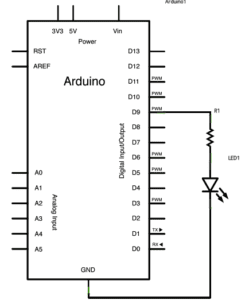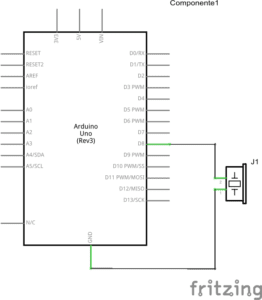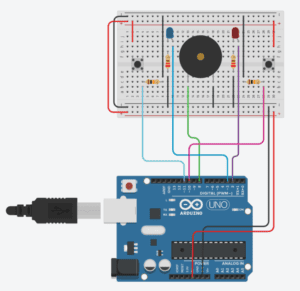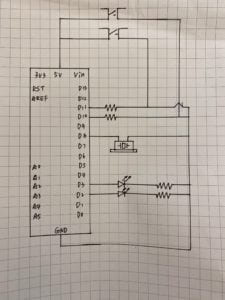In the second recitation of interaction lab, my partner Eric and I built three circuits: Fade, toneMelody, and Speed Game, using our own Arduino Kit.
Materials:
From Arduino Kit:
1 * Arduino Uno
1 * USB A to B cable
1 * breadboard
1 * buzzer
2 * LEDs
2 * 220 ohm resistors
2 * 10K ohm resistors
2 * pushbuttons
A handful of jumper cables
From cart:
2 * arcade buttons
Circuit 1: Fade

Code: Arduino>File>Examples>03.Analog>Fading
The first circuit is quite simple. What we need to connect the LED with a resistor to make its light fade. We didn’t have any trouble in building this circuit and finished it quickly.
Circuit 2: toneMelody

Code: Arduino>File>Examples>02.Digital>toneMelody
The second circuit is also very simple. After we finished it, my partner suggested that we could put the code in the “void loop” function to make the melody played repeatedly. We successfully made it, and were quite excited to find it worked.
Circuit 3: Speed Game


The description of the game: This is a two player game where each participant races to click a button more than their opponent. After 10 seconds, whoever has clicked their button the most and fastest wins!
This circuit is the most complex one among those I have encountered. It took us about 20 minutes to let it work successfully. After we finished building it for the first time, we found that it was not working. We examine the circuit that we built carefully and found that we added a wrong wire. We fixed the problem and successfully finished it.
Circuit 4: Four-player Speed Game
We spent too much time on building circuit 3. As a result, we didn’t have time to build circuit 4.
Question 1: Reflect how you use technology in your daily life and on the circuits you just built. Use the text Physical Computing and your own observations to define interaction.
Answer:
Technology exists everywhere in modern life, even if we haven’t realized this fact. We enjoy the convenience that technology brings us, but seldom thinking about the operating system behind these “machines”. While building those circuits in the recitation, I directly contacted the algorithm and programming hidden in the systems and realized how complex they are.
According to Introduction to Physical Computing, our interaction with computers consists of three parts – “input, output, and processing”. In my opinion, interaction is the process of information transfer and the coordination of the various components. Interaction brings magic.
Question 2: Why did we use the 10K resistor with the push button?
Answer: 10K is a high resistor value, which enables a low current to pass the circuit, thus protecting the circuit.
Question 3: If you have 100,000 LEDs of any brightness and color at your disposal, what would you make and where would you put it?
Answer: I will put those LED along an originally dark alley, making it glittery. It will light up the path, and make those who pass through this alley every day feel warm and safe.